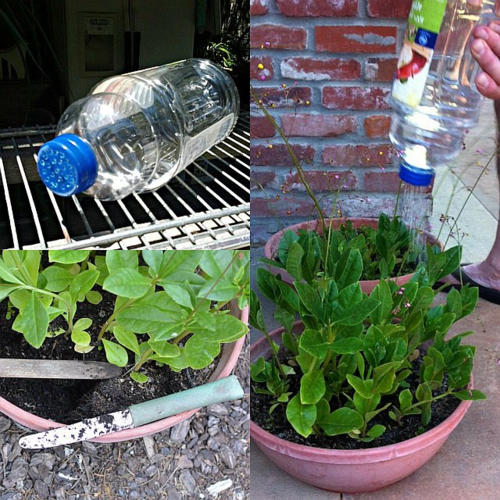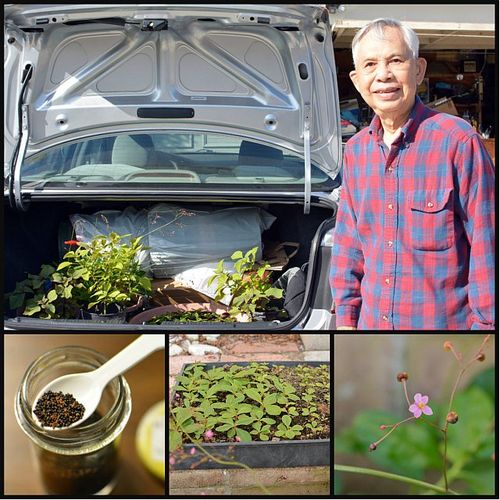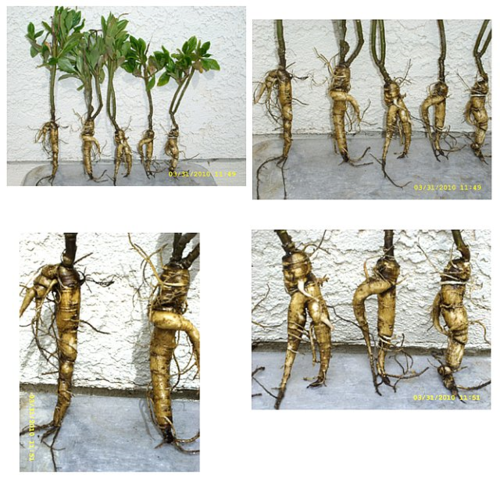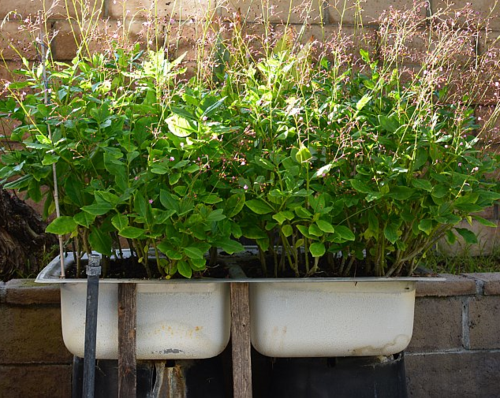My dad (above) had two stents put into his heart last month. We all sent him our good wishes and prayers and sighed big time when things went smoothly. Interestingly, leading up to the operation, Bo Gia (old Daddy in Vietnamese) emailed me about growing ginseng. He sent photos and directions on how to cultivate it at home, insisting that we could do it in Santa Cruz. I think the thought of cultivating something in the garden helped him take his mind off his health.
Bo Gia recounted how he got hooked on growing ginseng: He has a 96-year-old buddy in Wisconsin who up to a few years ago when he had bypass surgery, used to drive himself from the Great Lakes to California for reunions with my dad and other men of their former military promotion in Vietnam.
The vitality of the man impressed my dad, who queried the gentleman and found out that among his secrets to longevity was growing and eating ginseng. The man gifted my dad seeds years ago, and the roots at below represent three (3!) years of cultivation.
It’s hard to grow the roots for ginseng -- called sam (“sum”) in Vietnamese but as you can see, they are hilarious looking. Bo Gia keeps his stash frozen and once in a while he takes it out to look at, and we all crack up. They look like dancing girls, ginseng Rockettes.
In any event, Bo Gia wanted to encourage us to grow ginseng because (1) it is easy and (2) the leaves good for health. His Southern California yard is full of starts in shallow pots and maturing ones in deep pots. We visited him soon after his stent operation and he was recovering steadily, though still a bit weak. However, he never wavered from his mission with the plants. He got Rory going on loading up our car trunk with starters and gardening gadgets he fashioned out of recycled stuff.
Then he got out a little jar filled with seeds saved from 2013. He told me to send seeds to you for growing your own! It's a fun hobby. Currently our plants are not thriving but the delicate flowers are charming. Years will have to pass before there are any sizeable roots but we'll try to be patient. That's what gardening is like.
So if you want to grow ginseng, email me your address and I’ll send you seeds. First come first served. After you receive the seeds, follow my dad’s directions:
[8/1, 7am PST, UPDATE: I'm out of seeds to send. I was able to make 45 packets of the seeds (they're tiny, the size of poppy seeds) and they're all taken. Guess this is a popular thing, eh?]
How to Grow Ginseng
Start the plants in a shallow (about 4 inches / 10 cm deep) container. Cover lightly with soil and water gently to keep moist. Let the plants get to about a handspan’s height, then transplant them to a deep pot.

For the deep pots, recycle some 5-gallon ones. My dad used to own a landscaping business so he has a small collection of them but he also uses a recycled kitchen sink. The point is you need a deep space to grow ginseng well. With a deep 5-gallon pot, use some small wood chips. One bag would be enough. Throw the chips into the pot to fill about 4 inches, then add good planting soil up to the rim. (If the planter is about 12 inches (30 cm) deep, no chips are needed.)
To transfer the young ginseng plants, take each carefully with the soil around it, then arrange them into the pot. Use an old dinner knife to cut around each plant, dig deep and take it out.
Arrange the pots in a location that gets partial sun. Morning sun would be good. (During winter time better hide them in the garage?)
For watering, the sam needs water but not too much, as too moisture could make the roots rotten. Use a sturdy plastic bottle as a watering can. Punch the cap punched with holes so you can use less water (good for conservation purposes, though it would take time for the watering). Fill it up, reverse it upside down and side press it.
Water every 2 or 3 days depending on your local moisture condition. Remember to not over water.
When the plants are stabilized and growing up good, trim the leaves close to the soil level to help the plants grow faster and bigger. Whenever they grow big with a lot of leaves, harvest the leaves for making soup. Having this soup at dinner time can give you a very good night sleep.
If the plants look “sad,” it means that the roots of the plant are rotten. Dig the plant out, cut off at the very base and replant them. Use the roots if possible. The dying plant will come back and give plenty of leaves for the daily soup, but the roots seem to grow laterally instead of vertically as originally. Trim off some leaves before replanting to help the plants to re-grow. It is hard to grow the roots but the leaves are very good for soup.
Good luck and God bless.
Bo Gia
If you take on this project, email me photos and I’ll share them. I know that Bo Gia would love to see your progress as a ginseng grower.
Sorry folks, as of 8/1 at 7am PST, all 45 seed packets that I made are taken.




















jefferson saunders says
Xin Chao Anh,
Just came across your posting and loved reading your story.
Currently I live in SaiGon and am fortunate to have a huge garden 8000sqft (minus house).
I love the idea for growing Ginseng and hope it is possible in South Vietnam.
You have inspired me to give it a go. Needs to do pot due to rains and flooding.
Living in Binh Thanh p11 SaiGon.
Am on Facebook
Thank you
Jolene says
I know you said you were out of seeds but when they produce more I’d absolutely loved if you would send me some. Been wanting to grow some for a while now.
Andrea Nguyen says
I'm sorry but I am out of seeds.